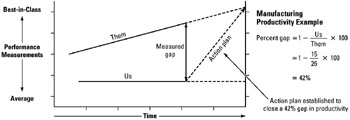Tool 17: Benchmarking
| AKA | Comparative Benchmarking |
| Classification | Data Collecting (DC) |
Tool description
Benchmarking, made popular by Robert C. Camp, is a data collection method that identifies and measures similar processes, products, and services against those of organization, considered best-in-class. All benchmarking projects, inside or outside the organization, generally collect and compare strategic, performance, or process benchmarks for the purpose of identifying gaps in performance and establishing gap-closing action plans.
Typical application
-
To identify areas that require process improvement.
-
To verify and measure an organization's performance against that of the competition.
-
To research trends and performance data of similar organizations for the purpose of developing strategic action plans.
Problem-solving phase
| → | Select and define problem or opportunity |
| → | Identify and analyze causes or potential change |
| Develop and plan possible solutions or change | |
| Implement and evaluate solution or change | |
| → | Measure and report solution or change results |
| Recognize and reward team efforts |
Typically used by
| 1 | Research/statistics |
| Creativity/innovation | |
| Engineering | |
| Project management | |
| Manufacturing | |
| 4 | Marketing/sales |
| Administration/documentation | |
| Servicing/support | |
| 2 | Customer/quality metrics |
| 3 | Change management |
before
-
Data collection strategy
-
Idea Grid
-
Interview technique
-
Surveying
-
Customer Needs Table
after
-
Action plan
-
Activity cost matrix
-
Information Needs Analysis
-
Force Field Analysis (FFA)
-
Competency Gap
Notes and key points
-
Quantitaive and qualitative data is collected in a benchmarking project as shown in the example. A different version of the benchmarking process can be illustrated.

Recommendation: An action plan for closing any existing gap should also consider the competitor's trendline in order to reach at least parity at some future date (goal).
Step-by-step procedure
-
STEP 1 First, the benchmarking team identifies processes to benchmark that are of great importance to the customer and the organization. See example Training and Development Services.
-
STEP 2 Similar organizations are targeted and selected on the basis of their excellence in certain fields.
-
STEP 3 Partnerships are formed with selected organizations. A set of common operational definitions is developed for processes, key characteristics, and metrics.
-
STEP 4 Desired benchmark data is collected (exchanged), using various data collection methods such as interviews, surveys, historical files, and other methods.
-
STEP 5 Collected benchmarks are analyzed and best-in-class performance data identified.
-
STEP 6 A gap analysis is performed and priorities established for certain identified areas in need of improvement.
-
STEP 7 Finally, an action plan is developed to close the performance gaps.
Example of tool application
Training and Development Services
| Quantitative (Numeric)
| Year xxxx | This Co. | Co.A | Co.B | Co.C | Co.D |
| Efficiency ratio | 2367:1 | 1230:1 | 80:1 | 488:1 | 667:1 | |
| $/Student hr. | $12.50 | $36.23 | $13.60 | $45.16 | $22.17 | |
| %Platform time | 54% | NA | 20% | NA | 40% | |
| Hrs/student | 28 | 40 | 208 | 51 | 8 | |
| Effectiveness ratio | 1:1.59 | NA | 1:2 | NA | 1.10:1 | |
| Expertise% | 100% | 95% | 73% | 98% | 100% | |
| Expertise% | 90% | 95% | 80% | 95% | 20% | |
| Flexibility% | 100% | 100% | 100% | 100% | 67% | |
|
[1]Notes: Benchmarks B–C (self-sufficiency) NA = No Benchmark data available | ||||||
EAN: 2147483647
Pages: 326